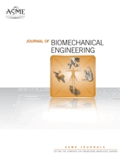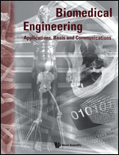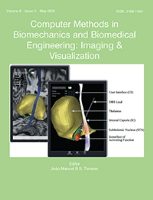
JOURNAL OF BIOMECHANICAL ENGINEERING-TRANSACTIONS OF THE ASME
Scope & Guideline
Unveiling the Mechanics Behind Biological Phenomena
Introduction
Aims and Scopes
- Biomechanical Modeling and Simulation:
The journal publishes research on computational models that simulate the biomechanics of human and animal systems, including finite element analysis and multiscale modeling approaches. - Soft and Hard Tissue Mechanics:
Research focusing on the mechanical properties of various biological tissues, such as cartilage, bone, and soft tissues, is a core area, including studies on viscoelasticity and anisotropic behavior. - Prosthetics and Orthotics Engineering:
The design, evaluation, and optimization of prosthetic and orthotic devices are key topics, emphasizing innovations that improve functionality and user experience. - In Vivo and In Vitro Experimental Biomechanics:
The journal features studies that employ experimental methodologies to investigate biomechanical phenomena, contributing to the understanding of tissue responses under various loading conditions. - Biomechanics in Rehabilitation and Injury Prevention:
Papers addressing the application of biomechanics in therapeutic interventions, injury prevention strategies, and rehabilitation protocols are regularly featured. - Multiscale and Multiphysics Approaches:
The integration of multiple physical principles and scales in biomechanical research is highlighted, showcasing the complexity of biological systems. - Biomechanics of Movement and Gait Analysis:
Research on human movement, gait analysis, and the biomechanics of physical activities is a significant focus, contributing to fields such as sports science and rehabilitation. - Innovative Biomaterials and Tissue Engineering:
The journal includes studies on the development and mechanical testing of biomaterials for applications in tissue engineering and regenerative medicine.
Trending and Emerging
- Machine Learning and AI in Biomechanics:
The integration of machine learning techniques for modeling, data analysis, and predictive modeling in biomechanics is on the rise, reflecting the growing importance of computational intelligence in understanding complex biological systems. - Personalized Medicine and Patient-Specific Models:
There is an increasing focus on developing patient-specific biomechanical models that tailor treatments and interventions to individual anatomical and physiological characteristics, enhancing the efficacy of biomedical applications. - Mechanobiology and Tissue Engineering:
Research exploring the interaction between mechanical forces and biological responses, particularly in the context of tissue engineering, is gaining prominence, highlighting the importance of mechanotransduction in health and disease. - Wearable Technology and Biomechanics:
The development of wearable sensors and devices that monitor biomechanics in real-time is becoming a significant area of interest, particularly for applications in rehabilitation, sports science, and health monitoring. - Biomaterials for Regenerative Medicine:
Innovations in biomaterials that can mimic the mechanical properties of biological tissues and promote healing are a growing focus, with implications for various applications in surgery and tissue repair. - Biomechanics of Aging and Degenerative Conditions:
Research addressing the biomechanical aspects of aging populations and degenerative diseases, such as osteoarthritis, is increasingly prevalent, reflecting the need for solutions to age-related biomechanical challenges. - Fluid-Structure Interaction in Biological Systems:
Studies investigating how fluids interact with biological structures, especially in cardiovascular and pulmonary research, are trending, emphasizing the complex dynamics of biological systems.
Declining or Waning
- Classic Mechanical Engineering Applications:
Research focused solely on traditional mechanical engineering principles without a clear biological application has declined, as the journal increasingly emphasizes interdisciplinary studies that bridge engineering and biological science. - Basic Theoretical Studies:
Papers that present purely theoretical models without experimental validation or practical applications are becoming less common, as the trend shifts towards more applied research with direct implications for biomedical engineering. - Historical Reviews of Biomechanics:
The publication of historical reviews or retrospective analyses of biomechanics has decreased, reflecting a shift towards contemporary studies that address current challenges and future directions in the field. - Non-Clinical Studies:
Research that does not directly translate to clinical applications or that lacks relevance to patient outcomes is becoming less favored, as the journal seeks to enhance its impact on biomedical engineering practices. - Focus on Non-Biological Systems:
Studies that explore biomechanical principles in non-biological systems are less frequently published, as the journal prioritizes research that has direct implications for human health and biomechanics.
Similar Journals

Acta Mechanica et Automatica
Connecting Ideas, Driving Engineering ExcellenceActa Mechanica et Automatica is a leading open-access journal published by SCIENDO, dedicated to the dynamic fields of Mechanical Engineering and Control and Systems Engineering. Since its inception in 2012, this journal has provided a vital platform for researchers and professionals to disseminate innovative findings and advances within these disciplines, boasting a convergence of years up to 2024. Based in Warsaw, Poland, the journal has embraced open access since 2013, ensuring broad dissemination of knowledge for the academic community globally. With a current Scopus ranking placing it in the 25th to 31st percentile among its peers, it plays an essential role in fostering scholarly communication and collaboration. The objectives of Acta Mechanica et Automatica include promoting original research, facilitating dialogue between disciplines, and enhancing the understanding of complex mechanical and control systems. This journal is invaluable for researchers looking to explore cutting-edge methodologies, theories, and applications in engineering.

BIOMEDICAL ENGINEERING-APPLICATIONS BASIS COMMUNICATIONS
Advancing biomedical innovation through rigorous research.BIOMEDICAL ENGINEERING-APPLICATIONS BASIS COMMUNICATIONS is a prominent journal dedicated to the dynamic field of biomedical engineering, published by WORLD SCIENTIFIC PUBL CO PTE LTD. Since its inception in 1992, the journal has provided a platform for the dissemination of high-quality research and innovative applications within the biomedical engineering domain. Despite its current Q4 ranking in multiple categories such as Bioengineering and Biomedical Engineering, the journal serves as an essential resource for researchers and professionals seeking to explore the latest developments and practical applications in this interdisciplinary field. The journal is based in Singapore, reflecting the region's growing influence in scientific research and technology. Although it does not offer open access, it continues to attract submissions that enrich the scientific dialogue within its community. With a commitment to fostering knowledge and research collaboration, this journal remains a vital contributor to the ongoing advancements in biomedical technology and engineering.

COMPUTATIONAL MECHANICS
Catalyzing Breakthroughs in Mathematical ApplicationsCOMPUTATIONAL MECHANICS, published by SPRINGER, is a premier international journal that focuses on the intersection of applied mathematics, engineering, and computational methods. With a commendable Q1 ranking in multiple categories, including Applied Mathematics and Mechanical Engineering, this journal is pivotal for disseminating groundbreaking research and innovative methodologies that advance the field. The journal has steadily contributed to the academic community since its inception in 1986 and continues to lead discussions and practices in computational mechanics and related disciplines. With a robust impact reflected in its Scopus rankings—placing it within the top percentiles across various categories—COMPUTATIONAL MECHANICS serves as a crucial platform for researchers, professionals, and students seeking to explore and contribute to significant advancements in computational theory and mathematical applications. Although it does not currently operate under an open access model, the journal ensures wide accessibility through libraries and institutional subscriptions, fostering a rich exchange of knowledge in the global scientific community.

Acta of Bioengineering and Biomechanics
Exploring innovative solutions in bioengineering and biomechanics.Acta of Bioengineering and Biomechanics is a distinguished academic journal published by Wroclaw University of Technology, Faculty of Computer Science & Management, focusing on the interdisciplinary fields of bioengineering and biomechanics. Since its inception in 2005, the journal has provided a platform for innovative research and critical reviews that contribute to the advancement of knowledge in areas such as biomaterials, biomedical engineering, and biophysics. Despite its current Q4 ranking in several categories, including Bioengineering and Biomaterials, it serves as a valuable resource for emerging scholars and seasoned professionals alike, highlighting the evolving landscape of research in these dynamic fields. The journal brings together a diverse range of studies, fostering collaboration and creativity among its readership. With its commitment to disseminating high-quality research, Acta of Bioengineering and Biomechanics plays an essential role in nurturing academic inquiry and professional growth within the scientific community in Poland and beyond.

Journal of Biomimetics Biomaterials and Biomedical Engineering
Empowering Researchers to Revolutionize Biomedical ApplicationsThe Journal of Biomimetics Biomaterials and Biomedical Engineering, published by TRANS TECH PUBLICATIONS LTD, stands at the forefront of interdisciplinary research that merges biology with engineering to address real-world challenges in healthcare and material science. Since its inception in 2014, the journal has contributed valuable insights into the development of innovative biomaterials and biomedical applications, showcasing research excellence in its fields, including biotechnology and bioengineering. With an ISSN of 2296-9837 and an E-ISSN of 2296-9845, this journal provides a platform for both emerging and established researchers to disseminate their work, fostering knowledge transfer across the global scientific community. Currently positioned in the Q4 quartile across categories such as Bioengineering, Biomedical Engineering, and Biotechnology, it aims to enhance its impact through open-access policies and rigorous peer-review processes. With its headquarters in Germany, the journal welcomes diverse contributions from around the world, shaping the future of biomimetic technologies and advancing our understanding of complex biomedical systems.

Journal of the Serbian Society for Computational Mechanics
Advancing Computational FrontiersJournal of the Serbian Society for Computational Mechanics, published by the Serbian Society for Computational Mechanics, is a vital platform for advancing research and knowledge in the field of computational mechanics. Established in 2012, this journal serves the academic community by providing a forum for innovative studies, methodologies, and applications within computational mechanics, presenting valuable insights for researchers, professionals, and students alike. With an ISSN of 1820-6530 and a ranking of Q4 in Computational Mechanics, it carries an essential influence in the engineering realm, despite its current rank of 71 out of 89. The journal's commitment to scholarly excellence aims to foster collaboration and encourage interdisciplinary research, making it an important resource for those invested in the evolving landscape of computational methodologies. Although the journal currently does not offer Open Access options, it remains dedicated to disseminating knowledge that will resonate within the local and global scientific community.

Current Opinion in Biomedical Engineering
Empowering researchers with impactful reviews.Current Opinion in Biomedical Engineering is a renowned journal published by Elsevier, focusing on the cutting-edge developments and critical assessments in the fields of biomedical engineering and related disciplines. With an ISSN of 2468-4511, it provides a valuable platform for researchers and professionals to disseminate their insights and discoveries in areas such as bioengineering, biomaterials, and medicine. Its impressive impact factor positions it in the Q2 category for several fields, including Bioengineering and Biomedical Engineering, highlighting its influence and relevance in ongoing scientific dialogues. The journal’s unique format of opinion pieces and reviews encourages innovative thinking and fosters collaboration among experts. As an essential resource for those engaged in the life sciences and engineering, Current Opinion in Biomedical Engineering serves to stimulate discussion, promote knowledge exchange, and drive advancements in biomedical applications. Set in the Netherlands at Radarweg 29, 1043 NX Amsterdam, the journal is accessible through various academic platforms, enabling a global readership to engage with the latest scholarly work in this dynamic field.

European Journal of Human Movement
Elevating Standards in Physical Therapy ResearchThe European Journal of Human Movement, published by the University of Extremadura, Faculty of Sports Sciences in Spain, stands as a vital resource within the realms of Health, Physical Therapy, and Social Sciences. With its consistent commitment to Open Access since 2014, the journal facilitates the dissemination of high-quality research, fostering innovation and collaboration among scholars, practitioners, and students alike. The journal has carved out a niche in its categories, being ranked in the Q3 quartile across several fields, including Health (social science) and Physical Therapy, Sports Therapy, and Rehabilitation. With an ongoing publication timeline extending from 2019 to 2024, it aims to highlight contemporary issues, emerging trends, and groundbreaking studies within human movement sciences. Additionally, with its presence in the Scopus ranking and a determination to elevate research standards, the journal remains an essential platform for sharing knowledge and advancing professional practice in a rapidly evolving landscape.

Journal of Theoretical and Applied Mechanics
Connecting Researchers and Practitioners in MechanicsJournal of Theoretical and Applied Mechanics, published by the Polish Society of Theoretical and Applied Mechanics, stands as a leading platform for disseminating cutting-edge research in the realms of theoretical and applied mechanics. With its ISSN 1429-2955 and E-ISSN 1429-2955, this Open Access journal has been fostering academic dialogue since 2006, making knowledge readily accessible to researchers and practitioners alike. Based in Warsaw, Poland, the journal encompasses a wide breadth of topics within mechanics, appealing to a diverse readership including researchers, professionals, and students. The journal's current Scopus ranking places it within the 30th percentile of the field, emphasizing its relevance and contribution to the discipline. As it converges from 2007 to 2024, the Journal of Theoretical and Applied Mechanics is pivotal for those seeking to advance understanding and innovation in mechanical engineering and mathematics, making it an essential resource for anyone involved in these critical areas of study.

Computer Methods in Biomechanics and Biomedical Engineering-Imaging and Visualization
Empowering Biomedical Innovations with Computational MethodsComputer Methods in Biomechanics and Biomedical Engineering - Imaging and Visualization is a prominent academic journal published by Taylor & Francis Ltd, dedicated to the intersection of computational methods and biomedical engineering. With an ISSN of 2168-1163 and an E-ISSN of 2168-1171, the journal has become a crucial resource for researchers and professionals exploring innovative imaging and visualization techniques in healthcare. Covering a broad spectrum of topics, it aims to facilitate the advancement of knowledge in areas such as biomechanics, computational mechanics, and medical imaging. Holding a strong position in various Scopus rankings, including Q2 in Computational Mechanics, it offers valuable insights that foster interdisciplinary collaboration. Although it is not an open-access journal, researchers can access its rich repository of knowledge, which is instrumental in shaping future advancements in biomedical applications. The journal’s commitment to quality and relevance ensures that it remains an authoritative source for emerging trends and methodologies within the field, serving as a vital tool for academia and industry practitioners alike.